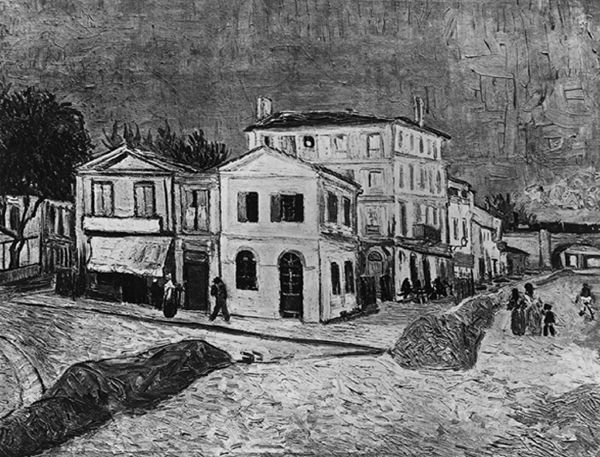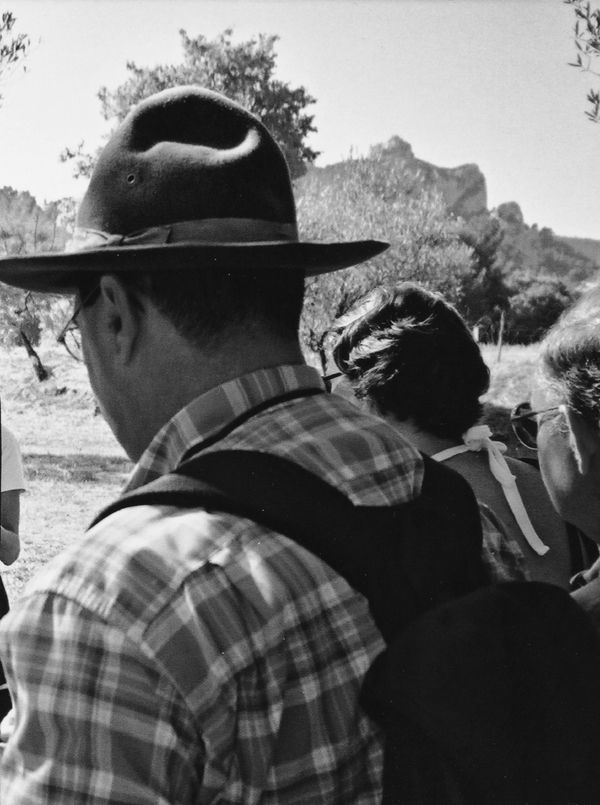旅行的艺术:艺术 Ⅶ 令人眼界大开的艺术-5
5
5
阿尔勒镇的旅游服务处位于小镇西南一条不起眼的混凝土街区里。游客可以在此拿到免费的地图,查询饭店、文化节、孩童看护、品酒、泛舟、历史遗迹和市场等资讯。但此处有一点特别突出,在大厅门口一张向日葵簇拥下的海报上写着:“欢迎来到凡·高的领地”,而大厅的墙上则被饰以丰收的场景、橄榄树和果园。
The tourist office in Arles is housed in an undistinguished concrete block in the south-western part of the town. It offers visitors the usual fare: free maps, information on hotels, cultural festivals, child-minders, wine tastings, canoeing, ruins and markets. But one attraction is emphasized above all others. 'Welcome to the land of Vincent van Gogh,' exclaims a poster with the sunflowers in the entrance hall, while the walls inside are decorated with harvest scenes, olive trees and orchards.
旅游服务处特别向游客们推荐被称作“凡·高的足迹”的项目。凡·高1890年去世,在他逝世100年的纪念日,凡·高在普罗旺斯待过的地方都能看到一系列的饰板——这些饰板被安装在金属板或是石板上——放置在那些凡·高曾经画过的地方用以表达对凡·高的敬意。饰板上贴着凡·高画作的复制品,并加上了几行解说词。不管是城里,麦田或橄榄园都看得到这样的饰板,甚至在圣雷米也有。他在割耳事件发生后不久便被送入此地的疗养院,他在普罗旺斯的日子就在这里告终。
The office particularly recommends what it describes as 'a Van Gogh trail'. On the hundredth anniversary of his death in 1890, Van Gogh's presence in Provence was honoured by a series of plaques-fixed on to metal rods or stone slabs-positioned in places that he painted. The plaques feature photographs of the relevant works and a few lines of commentary. They are to be found both within the town and in the wheat and olive fields that surround it. They extend as far as Saint-Rémy, where, after the ear incident, Van Gogh ended his Provençal days at the Maison de Santé.
我说服了我的主人们,打算花费一个下午的时间追寻凡·高的足迹,于是我们来到旅游服务处领取地图。很偶然的,我们得知有一个一周一次由导游带领的游览项目,游客们在院子里整装待发,而名额未满,价格也还合适。我们和好些热爱凡·高者一同报名参加了这项活动。导游名叫索非娅,是巴黎索邦神学院的一名学生,正在撰写一篇有关凡·高的论文。在她的带领下,我们到了此行的第一站:拉马丁广场。
I persuaded my hosts to spend an afternoon following the trail and so we travelled to the tourist office to collect a map. By chance, we learnt that a guided tour, a once-weekly event, was about to start in the courtyard outside and that there were still places available for a modest sum. We joined a dozen other enthusiasts and were first taken to the Place Lamartine by a guide, who told us that her name was Sophie and that she was writing a thesis on Van Gogh at the Sorbonne in Paris.
1888年5月初,因为觉得自己住的旅馆太贵,凡·高租下了位于拉马丁广场2号的一座建筑物的一侧,这就是著名的“黄色小屋”。这座“黄色小屋”的外墙被他的主人漆成了明亮的黄色,而屋内却没有。凡·高对于房屋内部的设计产生了极大的兴趣。他想让它显得单纯而朴素,具有南方的色彩:红色、绿色、蓝色、橙色、硫磺色和淡紫色。“我想让它真正成为‘一间艺术家之屋’——没有什么昂贵的东西,但是从椅子到图画,每一样东西都有特色,”他这样告诉他的弟弟。“至于床,我已经买了乡间常用的床,不是铁床,而是大的双人床。它的外表给人坚固、耐久且恬静的印象。”重新装饰完成之后,他得意地写信给他的妹妹:“我在这里的房子,外面漆成鲜黄油般的黄色,搭配着耀眼的绿色百叶窗,房子在一个广场中,沐浴在灿烂的阳光下,这房子有一个绿色的花园,里面种了梧桐、夹竹桃和洋槐。房子里面的墙完全被刷成白色,地板由红色的砖块铺就。在房子的上空就是耀眼的蓝天。在这间房子里,我可以生活、呼吸、沉思和作画。”
At the beginning of May 1888, finding his hotel too expensive, Van Gogh had rented a wing of a building at 2 Place Lamartine known as 'the Yellow House'. It was one half of a double-fronted building, which had been painted bright yellow by its owner but left unfinished inside. Van Gogh developed a great interest in the interior design. He wanted it solid and simple, painted in the colours of the south: red, green, blue, orange, sulphur and lilac. 'I want to make it really an artist's house -nothing precious , but everything from the chairs to the pictures having character,' he told his brother. 'About the beds, I have bought country beds, big double ones instead of iron ones. That gives an appearance of solidity, durability and quiet.' The refurbishment complete, he wrote elatedly to his sister: 'My house here is painted the yellow colour of fresh butter on the outside with glaringly green shutters, it stands in the full sunlight in a square which has a green garden with plane trees, oleanders and acacias. And it is completely whitewashed inside, and the floor is made of red bricks. And over it there is the intensely blue sky. In this I can live and breathe, meditate and paint.'
令人遗憾的是,索非娅并没有什么可以展示给我们,因为“黄色小屋”已毁于二战,取而代之的是一座青年旅馆,并且由于旁边是一座巨大的“均价”商店(法国的一种专售廉价商品的连锁店),而显得更加矮小。因此我们驱车前往圣雷米,在凡·高曾经住过和在那进行绘画活动的疗养院周围的田地里待了一个多小时。索非娅随身携带了一本巨大的塑料封面的书,里面有凡·高在普罗旺斯期间主要的绘画作品,她经常在凡·高曾经到过的地方将它举起来,让我们围在身边凝视。当她背对着阿尔卑斯山,举起《以阿尔卑斯山为背景的橄榄树》(1889年6月)时,大家纷纷赞叹这片景色和凡·高的作品。但是,在团队中偶尔也能听到异议:在我身旁,一个戴着大帽子的澳大利亚人对他的同伴——一个头发蓬乱的娇小女人——说:“嗯,它看上去并不很像这片景色。”
Sadly Sophie had little to show us, for the Yellow House had been destroyed in the Second World War and replaced by a student hostel, dwarfed by a giant Monoprix supermarket beside it. So we drove to Saint-Rémy and there spent more than an hour in the fields around the asylum where Van Gogh had lived and painted. Sophie had with her a large plastic-coated book containing the main Provence paintings and she frequently held it up in a spot where Van Gogh had worked and we peered around to see. At one moment, with her back to the Alpilles, she held up Olive Trees with the Alpilles in the Background (June 1889) and we admired both the view and Van Gogh's version of it. But there was a moment of dissent in the group. Next to me, an Australian wearing a large hat said to his companion, a small tousled-haired woman, 'Well, it doesn't look much like that.'

凡·高:《阿尔勒的黄色小屋》,1888年
凡·高的确担心这样的批评。他写信给他的妹妹说,许多人说过,他的作品看上去太怪异,还有一些人甚至认为他的作品一无是处,令人厌恶至极,其原因不难发觉。在他的画中,房子的墙并非总是直的,太阳并非总是黄色的,甚至草也并非总是绿色的,他画的树摆动得有些夸张。“我的确对色彩的真实情况做了某种改变,”他承认,并同时也对比例、线条、阴影和色调作了类似的改变。
Van Gogh himself had feared he might encounter such accusations. To his sister, he wrote that many people already said of his work: '“This really looks too strange,” not to mention those who think it a total abortion and utterly repulsive.' The reasons weren't hard to find. The walls of his houses weren't always straight, the sun wasn't always yellow or the grass green, there was an exaggerated movement in some of his trees. 'I have played hell somewhat with the truthfulness of the colours,' he admitted, and he played similar hell with proportion, line, shadow and tone.
然而,改变真实情况对于凡·高而言,仅仅是将那个所有的艺术家都会被卷入其中的过程表达得更加清楚——也即,选择将现实中的哪些方面包含在画中,哪些方面排除出去。正如尼采所了解的,现实本身是无穷的,也永远无法全部被表现于艺术之中。在普罗旺斯的画家当中,凡·高之所以独树一帜,是因为他选择自己感觉最重要的东西来表达。而像康斯坦丁这样的画家,花费了巨大的努力画起来则中规中矩,努力追求正确的尺寸。凡·高虽然对于创造一种“相似性”很感兴趣,但是却并不担心尺寸的问题,只在意画出他认为最能表现南方特色的地方;他告诉他弟弟,他追求的“像”不同于虔诚的摄影师所追求的逼真。他所关注现实中的那一部分,有的时候需要加以扭曲、省略或者更换颜色,方能在画面上表现出来,但是依然使他感兴趣的是真实——“相似性”。他愿意牺牲一种幼稚的现实主义来成就一种更加深刻的现实主义,就像一个诗人,在描述一件事件时虽然比不上一名记者来得真实,但是却可能揭示出在记者严谨的文字框架内无法找到的事件的真相。
Yet in playing hell Van Gogh was only making more explicit a process in which all artists are involved-namely, choosing what aspects of reality to include and what to leave out. As Nietzsche knew, reality itself is infinite and can never be wholly represented in art. What made Van Gogh unusual among Provençal artists was his choice of what he felt was important. A painter like Constantin had expended much effort in getting the scale right. Van Gogh, though passionately interested in producing a 'likeness', insisted that it wasn't by worrying about scale that he would end up conveying what was important in the south; his art would involve, as he mockingly told his brother, 'a likeness different from the products of the God-fearing photographer'. The part of reality that concerned him sometimes required distortion, omission and substitution of colours in order to be brought to the fore, but it was still the real '-the likeness'-that interested him. He was willing to sacrifice a naïve realism in order to achieve a realism of a deeper sort, behaving like a poet who, though less factual than a journalist in describing an event, may nevertheless reveal truths about it that find no place in the other's literal grid.
1888年9月,凡·高写了封信给他的弟弟,谈到他计划要画的一幅肖像画:“与其尝试着去精确再现展示在我面前的图景,我更加倾向于随心所欲地运用色彩,为的是有力地表达我自己……我将给你一个例子来说明我的想法。我打算画一个艺术家朋友的肖像,他是一个怀有伟大梦想的人,天生就热爱自己的工作。(这就是他在1888年9月初画的《诗人》)。在我的画中,他将会是一个金发碧眼的人。我想将我对他的欣赏,我对他的爱,放进这幅画中。因此,开始时我尽可能忠实地把他画出来。但是这幅画仍然没有完成。为了完成这幅画,我的用色将非常专断、大胆。我对他亮丽的头发进行了夸张,我甚至调出了橙色调、铬黄色和苍白的淡黄色。他背后那道普普通通的墙,我则用我能想出的最饱满、最强烈的蓝色作为背景,通过这种明亮的头部与饱满的蓝色背景的简单结合,我获得了一种神秘的效果,好像一颗星星在一片天蓝色夜空的深处……哦,我亲爱的弟弟……那些中规中矩的人们只会将这种夸张看作是一幅漫画。”
Van Gogh elaborated on the idea in a letter to his brother in September 1888 concerning a portrait he was planning: 'Instead of trying to reproduce exactly what I have before my eyes, I use colour more arbitrarily, in order to express myself forcibly … I'm going to give you an example of what I mean. I should like to paint the portrait of an artist friend, a man who dreams great dreams, who works as the nightingale sings, because it is his nature [this was Poet of early September 1888]. He'll be a blond man. I want to put my appreciation, the love I have for him, into the picture [my italics]. So I paint him as he is, as faithfully as I can, to begin with. But the picture is not yet finished. To finish it I am going to be the arbitrary colourist. I exaggerate the fairness of the hair, I even get to orange tones, chromes and pale citronyellow. Behind the head, instead of painting the ordinary wall of the mean room, I paint infinity, a plain background of the richest, intensest blue that I can contrive, and by this simple combination of the bright head against the rich blue background, I get a mysterious effect, like a star in the depths of an azure sky … Oh, my dear boy … and the nice people will only see the exaggeration as a caricature.'

普罗旺斯圣雷米的凡·高之路
几周以后,凡·高开始另一幅“漫画”。“今晚我想开始画一间咖啡馆。它晚上点着煤气灯,是我吃晚餐的地方,”他告诉他弟弟,“这种地方叫作‘夜间咖啡馆’(它们在这里相当普通),整夜都开着。夜晚四处游荡的人们,如果没有钱支付一间寓所或者醉得无法被抬进寓所,可以在这里寄宿。”在创作《阿尔勒镇的夜间咖啡馆》这幅作品时,凡·高为了表现现实的其他内容而不再拘泥于“现实”的某些要素。他并没有再现景观本身或是咖啡馆的色彩,咖啡馆的灯泡变形为发光的蘑菇,椅子的背弯成弓形,地板翘了起来。然而他依然感兴趣于表达他对这个地方的真实想法,而如果他必须遵循艺术的那些经典规则,恐怕无法像这样将他的这些想法表现出来。
A few weeks later, Van Gogh began another 'caricature'. 'Tonight I am probably going to start on the interior of the café where I eat, by gaslight, in the evening,' he told his brother. 'It is what they call a “café de nuit” (they are fairly common here), staying open all night. Night prowlers can take refuge there when they have no money to pay for a lodging or are too drunk to be taken in.' In painting what would become The Night Café in Arles , Van Gogh abandoned adherence to some elements of 'reality' for the sake of others. He did not reproduce the proper perspective or colour scheme of the café, his gaslights metamorphosed into glowing mushrooms, the chairs arched their backs, the floor buckled. Yet he was still interested in expressing truthful ideas about the place, ideas that would perhaps have been less well expressed if he had had to follow the classical rules of art.
- 频道推荐
- |
- 全站推荐
- 推荐下载
- 网站推荐


















